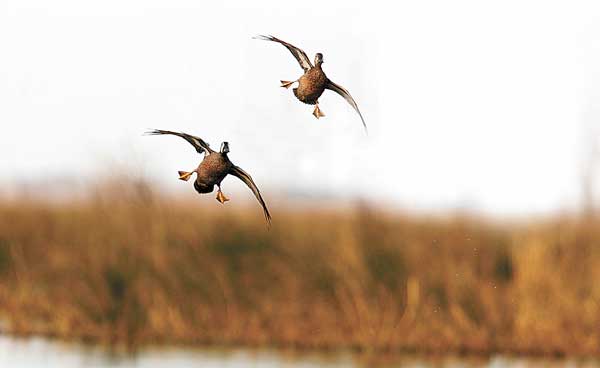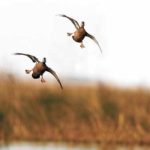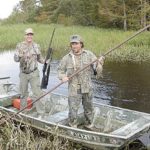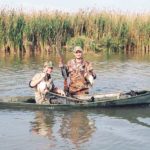
Recent aerial surveys show there are some spots in Plaquemines Parish that still hold duck food.
Eddie stormed into Doc Fontaine’s Venice houseboat, slammed the door and hurled his camo duffel bag in the corner.
The look on his face said trouble. His eyes were wild and bloodshot, his face creased in a crazy grin. Worse, some friends of Trisha (Doc’s current girlfriend, formerly from California) were also on hand for the festive weekend.
Pelayo, Chris and I had arrived only an hour before, primed for standard Venice-houseboat conversational fare — serious Tigertown reminiscing and ribald repertoire, with much overlap between the two.
Trisha has finally been acclimated to the routine, unlike our wives, who generally excuse themselves from these “outdoor” forays. All were eyewitnesses (and often participants!) in the Tigertown debauchery, so who can blame them?
Alas, Doc and Trisha had gone for a ride, trying to hunt down some Pinot Grigio, an item that fills their wine cellar at home but one they’d inexplicably forgotten to pack for this trip. Pelayo’s cell phone inquiry quickly disclosed that each blamed the other for the gaffe. But they’d found some at a local convenience store, and were hurrying back with half a dozen bottles.
It took them 15 minutes to return. Those 15 minutes were filled with insufferable sermonizing by Gail and Meaghan about environmental matters. The flyfishing gear in the corner should have been a tip-off. Yes, these gals were flyfisherpersons — hence typically preachy greenies. The oil-exploration ambiance down here horrified them.
Pelayo, Chris and I merely nodded and shrugged at their Al Gore-esque blather. But the night was young and most of the booze uncorked, unpopped and unscrewed. So the evening fairly pulsated with fantastic potential for spirited conversation as the sun would soon begin settling behind the old Getty refinery whose structure so horrified the sensibilities of our California guests.
Ten minutes after Doc and Trisha’s return came Eddie’s grand entrance. He hurled his duffel bag right next to some of Gail and Meaghen’s baggage, plastered with the trite enviro-stickers. Eddie immediately noticed them. This was like lobbing meat to a ravenous Tasmanian Devil.
Doc looked over at Pelayo and me with an eye roll as Eddie made a show to bend down and study one such sticker, spilling half his beer on one of their Columbia-gear packs in the process.
“Love Your Mother!” Eddie finally blurted, jerking himself upright, wobbling as he looked around the room, then pointing at the sticker of Mother Earth on the backpack. “Yeah, you right! I LOVE her alright!” and he looked around spilling what little was left of his beer as he tried to focus on Trisha. “I love driving my Hummer, and using only plastic bags. And murdering and torturing her offspring with my treble hooks, lures, guns and crossbow! And that recycle bin the garbage people provide ya? It makes a helluva live-bait well! Glad to have it!”
Then he bent over and moved in close to the aghast Gail and Meaghen’s very faces.
“And how y’all get down here from Malibu anyway — ride a mountain bike?” Eddie roared, sprinkling them with beer spittle. “And that trip with Doc and Trisha to the Cannes Film Festival? Huh? Was that on a mountain bike? A sailboat? A handglider? Heck, your carbon footprint dwarfs mine with all my blazing around in my Hummer and jet-skis!”
An interesting weekend loomed, no doubt.
Duck season opened the following week, but none of us were pumped. In fact, we weren’t even sure if we’d hunt. It was the autumn after Katrina. An unusually low river during the spring and summer had compounded the marsh destruction of Katrina (a daughter of Earth goddess Gaia, right? Unlike a dragline or dredge, right?). The normally river-nourished and lush Mississippi delta appeared (from a distance) mostly denuded of duck fodder. We’d been on several fishing/duck-scouting trips, and things looked grim. It was hard to get pumped for the opener.
Trisha’s friends wanted to latch onto some bull reds with their fly-fishing paraphernalia (then release them, of course). So the next morning found Eddie, Chris, Pelayo and me following Doc, Trisha and the Greenie Gals down South Pass to fish the rocks.
We’d barely passed Head of Passes when Pelayo suddenly pulled back on the throttle and nodded left.
“Water looks pretty clear,” he pointed. “And heck, we always do good on the reds and trout in the spillways off Southwest pass this time of year, right? Well, let’s try this one.”
A radio call explained the matter to Doc, who waved and continued south as Pelayo turned shoreward and entered a spillway that snaked into the huge lagoon labeled Sawdust Bend Bayou on most maps.
We’d barely entered the roseau-shrouded channel when Chris pointed.
“Check ‘em out!” he said.
Four mottled ducks had erupted from a pond to our left.
“And over there!” Pelayo pointed up ahead.
Some more ducks were flapping away. All looked like mottled ducks.
“Are those pintail?” Eddie asked as a flock passed overhead.
“Sure are,” quipped Chris, as I pointed up ahead to a trio of teal blazing at roseau-top level. NOW the juices started flowing. NOW the prospect of paddling the ‘rogue, setting out the dekes and watching the glorious spectacle as they turned to our calls and closed the distance started taking hold in our heads.
We picked up a few reds and a flounder while weaving around casting along the roseau banks. The real treat, however, was the concentration of ducks we found. A film of duckweed covered some of the bank around here, and a few strands of millfoil and coontail were visible sprouting from the bottom in places. Pondweed also covered a few areas.
That magic elixir (for growing wild duck food) known as the Mississippi River had started rejuvenating parts of this area in only two months. Other southeast Louisiana marshes, deprived of this nourishment, would take much longer to bounce back.
And exactly as with deer during low mast-crop years, what ducks were in Southeast Louisiana were concentrated in the relatively few natural feeding areas. Most were in the delta.
Sure enough, the following Saturday found Pelayo, Chris and me standing in the roseaus in our waders. The ‘rogues were jammed into the canes behind us, and Pelayo’s Aquasport was also jammed into the canes and anchored in a 4-foot trennasse a couple hundreds yards to our west. The sun was just nudging the horizon as we’d thrown out the last deke into a small spread of 10.
This wasn’t like hunting the big open bays and lagoons down here. This was almost like pothole or even flooded-timber hunting, with the roseau and a few crippled willows as the timber.
We started quacking and whistling away to get into the spirit of the season, and in minutes, Chris was pointing left at a flock of six.
“Blacks,” hissed Pelayo.
Only in the deltas (both Mississippi and Atchafalaya) do we consistently find mottled ducks in actual flocks — rather than in their customary pairs — during the winter. Not that these saw our decoys or were enticed by our calling. Chances are they were among those we put up the week before and again a bit earlier this morning as we entered and set up. They just happened to be flying back, and at an angle that would take them right over us.
We hunkered down a bit (instinctive), and watched them close the distance through the cracks in our natural roseau “blind.” Their wings beat steadily. Their path was unwavering. None of that craning of the neck and looking around for company or a place to land. They knew where they were going.
A cool breeze lapped at our backs — just cool and brisk enough to keep the gnats off. We were seriously pumped — something we had hardly expected from the horrendous predictions for the season we’d been reading for two months.
The dekes danced on the end of their 6-foot lines. A crewboat roared down South Pass, and still they came. I caught movement, shifted my gaze and — WHAT?! Four greenwings were swimming amongst our dekes! Given the pessimistic prospects of two weeks ago, four teal by themselves would have been a superb bag for opening morning. But now we got greedy and nodded “no” to each while mouthing our calls.
“NO!” we gasped again, but from concern this time. The ducks appeared to be swerving. What did they see?
We hunkered lower and plastered our faces against the cane. Uh-oh, at about a hundred yards, the lead duck was definitely veering. The others followed. We mouthed the calls in desperation just as they swerved, and we saw the white of the underwings contrasting against the dark bellies. “Blacks” for sure.
At Pelayo’s raspy hail, the distant ducks slowed and seemed to swerve back on track. Chris and I chimed in with a few quacks and whistles, and Pelayo blasted out another hail — a short four-note one, not the Mariachi trumpeter kind you hear at duck-calling contests.
Now the ducks seemed genuinely interested. On they came, but still high until at about a hundred yards they locked up for good and started dropping almost STRAIGHT down.
It was amazing. Cupped wings are one thing. These cupped their wings in almost to the body for a rapid descent. Usually you start calling at ducks at that altitude, and they’ll circle three or four times. Not these. This was their living room they wanted back in. We could even watch the wind rustling their wing feathers, and what a heavenly sound.
In seconds, they were almost on top of us. These had their wings spread wide, exposing their dark brown bellies as they hovered over the farthest decoys. Big orange feet started to dangle. This is normally a teal-season spectacle, when they titillate you, knowing they’re safe, knowing you can’t touch them,
Not now! My heart was in my throat as we rose to greet them at point-blank range.
“Blaaaam!” our three shots went off almost as one. Naturally, all three of us aimed at the same two ducks, and they crumpled. The others flapped off before we could recover our wits.
Much whooping and high-fiving, then Chris started sloshing toward the ‘rogue for a retrieve run. But Pelayo yanked him back by the arm. Another flock was heading straight for us. More blacks — big-bodied, deliberate wingbeat. Again, we hunkered, turning our faces slightly to watch their approach. They passed about 80 yards to the left, and I gave a short (three-note) hail.
One cupped immediately, and started banking. The others flew on. I called again, and again. And after another hundred yards, the remaining trio decided to join the first.
They were well in range as we rose. BLAM! BLAM! BLAM!! Two more “blacks” were in our bag — which finished out two hours later as seven mottleds, three teal and two pintail. No limits, but we were jubilant, and showed them off to great fanfare back at the marina.
Even more fanfare accompanied the consumption of their kabobbed and barbecued breasts and their gumbo-ed legs that night.
So, what’s up for South Louisiana coastal hunters this season, after the double-hurricane whammy?
More than you might think, for the resourceful and footloose. And our hunt two seasons ago gives a good clue.
“We flew an aerial survey all across Plaquemines Parish, north to south in early October,” said Todd Baker, the LDWF biologist in charge of Pass-a-Loutre WMA. “The picture in the north wasn’t pretty. But as soon as you got to, say, about Baptiste Collette, things got prettier, and prettier still farther south at Pass-a-Loutre.
“It’s hard to believe, but some of the delta duck potato (prime food for gadwall and pintail) fared pretty well. Much was killed, but we had so much from the high river this year that there’s a good amount left as duck food.
“By November, it’s the duck potato tubers in the mud that the ducks are rooting for, and those are still available. Much of the coontail and millfoil was killed but — amazingly — the pondweed, another prime food for puddle ducks, held up quite well in most of the Pass-a-Loutre WMA.
“That flow of river water — even with cooler temperatures and shorter days — will allow some of that millfoil, coontail and widgeon grass to start growing back in time for the duck season.”
Some biologists suspect that the Delta receives a migration of mottled ducks from nearby coastal marshes. Dr. Charles Stutzenbaker, retired from the Texas Parks & Wildlife Service, is among the nation’s top authorities on mottled ducks.
“Banding studies show that there’s some migration of these ducks, usually from west to east, usually because of water conditions,” he said. “The Mississippi Delta is actually the easternmost border of the mottled duck’s range. Tubers are among their favorite foods, especially the delta duck potato tuber. This explains their large numbers in places like the Mississippi and Atchafalaya deltas.
“I think you’re probably seeing large concentrations and flocks of them because there’s a lot of them born in the area in the first place. Then come the migrants from areas farther west.”
Given the food situation this year, the delta — as the main provider of such — should get even more such migrants.
“We’ve being seeing plenty of mottled ducks at Pass-a-Loutre this fall,” Baker said. “There’s always plenty, as you know, but this year we’ve been seeing more than usual.”
Not that “blacks” should be the only targets in the delta this year. As mentioned, in just a couple of months, river water starts the rejuvenation process with duck food sprouting wherever it flows. Pintails, greys and teal won’t be as numerous in the delta, but they’ll be concentrated in pockets.
If you’re like us, you’ll love discovering those pockets, especially considering the reds, puppy drum and flounder that usually end up in the box during such preseason discovery trips.




